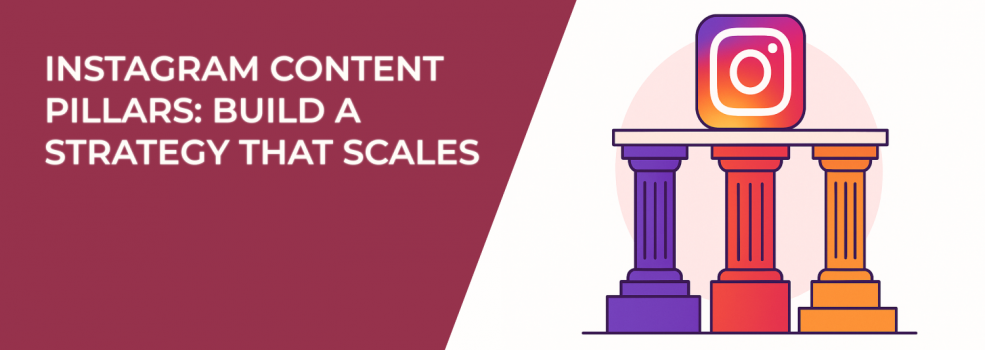When you think about Instagram strategy, it often feels overwhelming. Should you post behind-the-scenes videos? Product photos? Educational carousels? The truth is, without structure, your content becomes scattered and harder to scale. That’s where content pillars step in.
Content pillars are the foundation of your Instagram marketing plan. They’re the categories or themes that shape everything you publish. When you use them well, you build consistency, save time, and attract the right audience — while also making it easier to measure what’s working.
Let’s dive into how to create Instagram content pillars that actually help you grow, not just post for the sake of posting.
What Are Instagram Content Pillars?
Think of content pillars as the “big buckets” your posts fall into. For example, a fitness brand might use three main pillars: workout tips, client success stories, and nutrition advice. A SaaS company might focus on tutorials, case studies, and industry insights.
Why does this matter? Because Instagram rewards consistency. The algorithm learns who your audience is and who else might benefit from your content. When you stay within your defined pillars, you make it easier for the platform — and for your followers — to understand your value.
For a deeper look at how audiences behave across Meta platforms, check out Everything You Need to Know About Facebook Ads Audiences.
How to Choose the Right Content Pillars
Here’s the tricky part: you don’t want too many. Three to five is usually enough. Too few, and you’ll feel boxed in. Too many, and your content becomes messy.
When building your pillars, ask yourself:
-
What are the top problems my audience needs help solving?
-
What expertise can I consistently share?
-
What types of content drive engagement and conversions for my brand?
For instance, a B2B software company might land on:
-
Product education (how-to guides, short tutorials).
-
Customer stories (social proof that builds trust).
-
Industry trends (thought leadership that positions authority).
Notice how each of these serves a specific purpose — education, trust, and growth.
The Main Types of Instagram Content Pillars
Every brand will define its pillars differently, but most fall into a handful of proven categories. Here’s a list of the most common Instagram content pillar types:
-
Educational Content
-
How-to guides
-
Tutorials or tips
-
Industry insights and data
-
FAQs answered in posts or Stories
-
-
Entertaining Content
-
Memes or humorous posts
-
Relatable “day-in-the-life” clips
-
Trending audio or challenges
-
Fun behind-the-scenes moments
-
-
Inspirational Content
-
Motivational quotes
-
Customer or client success stories
-
Vision or mission-driven storytelling
-
Transformation journeys
-
-
Promotional Content
-
Product or service features
-
New launches and announcements
-
Limited-time offers or discounts
-
Ad teasers or campaign previews
-
-
Community & Engagement Content
-
Polls, Q&A sessions, or quizzes
-
User-generated content (UGC)
-
Shoutouts to followers, clients, or partners
-
Behind-the-scenes with your team
-
-
Authority-Building Content
-
Thought leadership posts
-
Case studies
-
Opinions on industry news
-
Lessons learned from experience
-
-
Lifestyle Content
-
Showing how your product fits into daily life
-
Seasonal activities or celebrations
-
Team culture and brand personality
-
Aspirational lifestyle storytelling
-
Not sure how these fit into an ad strategy? You may find Cross-Posting on Facebook and Instagram: Smart Move or Missed Opportunity? helpful for thinking through content distribution.
Bringing Content Pillars Into Daily Practice
So you’ve chosen your pillars. Now what? The key is weaving them into your content calendar. Don’t just list them and forget.
Here’s a simple system:
-
Rotate through your pillars weekly to maintain variety.
-
Repurpose across formats — one pillar topic might become a carousel, a Reel, and a Story highlight.
-
Track engagement and conversions by pillar to see which ones deserve more investment.
Imagine you’re an e-commerce brand. One week, your “product education” pillar could feature a how-to Reel on styling an item. Next week, that same pillar could deliver a carousel on care instructions. Different format, same core theme. This repetition with variation is what builds authority.
Examples of Content Pillars in Action
To make this more concrete, let’s break down a variety of hypothetical cases:
-
A skincare brand: education (ingredient science), product features (new launches, best sellers), lifestyle (self-care routines).
-
A marketing consultant: educational tips (growth strategies), personal insights (behind-the-scenes), client wins (proof of results).
-
An online course creator: free value (mini-lessons), credibility (testimonials), community (student highlights).
-
A real estate agency: property showcases, market insights, homeownership tips, behind-the-scenes of the buying process.
-
A fashion retailer: styling guides, seasonal collections, sustainability practices, customer-generated looks.
-
A nonprofit organization: mission stories, volunteer highlights, impact reports, educational campaigns.
-
A tech startup: product updates, industry analysis, team culture, customer case studies.
These examples show how flexible content pillars can be, no matter the industry. The goal is to choose themes that reinforce your brand’s identity while giving your audience a reason to keep coming back.
Why Content Pillars Scale
Here’s the real payoff: content pillars save time and keep your strategy scalable. When your team grows, or when you outsource content creation, the pillars act like a guidebook. Everyone knows what fits and what doesn’t.
This also makes advertising smoother. If you’re running Instagram ads, your content pillars align your organic posts with your ad campaigns. That consistency helps build trust and reinforces your messaging. Curious about ad costs? Check out How Much Do Instagram Ads Really Cost.
Scaling doesn’t mean posting more often. It means posting smarter, with a clear system that works even as you grow.
Quick Tips to Refine Your Pillars
-
Review them quarterly — audience needs shift, and your content should too.
-
Add subcategories for variety, but keep them under the main pillar.
-
Always tie back to your core brand values.
Ask yourself: would my followers instantly recognize this as mine? If the answer is yes, you’re on the right track.
Final Thoughts
Instagram content pillars aren’t a buzzword. They’re a practical tool that keeps your content organized, relevant, and scalable. Whether you’re running ads, focusing on organic reach, or both, pillars give you a framework that makes sense of the chaos.
If you’ve been feeling stuck on what to post next, try mapping out your three to five pillars today. You’ll not only reduce decision fatigue but also see your engagement and conversions climb over time.
For a broader perspective on targeting and strategy, read 2025 Instagram Ad Strategy: What Separates Good from Great.

